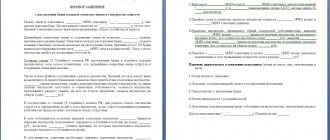Briefly about the seizure of property
A citizen who has a significant debt to another person and makes no attempt to repay it may fall under the procedure of forced collection of funds.
As part of enforcement proceedings, the bailiff has the right to seize the debtor’s property, guided by personal conclusions or based on the claimant’s statement. If there is a corresponding court decision, the procedure is carried out without fail. Purposes of arrest:
- safety of objects subject to sale or transfer to the creditor in case of non-payment of the debt;
- providing a guarantee that the claimant will receive the amount that rightfully belongs to him;
- motivating the debtor to repay the debt as quickly as possible.
The procedure itself involves the preparation of an appropriate act with an inventory of seized property. In relation to the latter, a number of restrictions arise in the future. The main one is the prohibition on the disposal of possessions.
The debtor has no right to perform the following actions with the seized property:
- sell;
- present;
- pass on by inheritance;
- rent out;
- exchange.
If necessary, restrictions may be established on the right to use property. Or items of property may be seized.
An encumbrance imposed by a court or bailiff is valid for the period specified in the relevant resolution. If the debtor fails to fulfill his obligations to the claimant within the established period, the seized objects will be put up for sale. And the proceeds after the sale will be used to pay off the debt.
The arrest procedure is fully regulated by Art. 80 of Law No. 229-FZ on enforcement proceedings. An arrest can also be carried out on the basis of Art. 115 Code of Criminal Procedure of the Russian Federation, Art. 140 Code of Civil Procedure of the Russian Federation, art. 77 Tax Code of the Russian Federation.
How to remove a seizure from real estate imposed by a court?
The level of professionalism of civil servants, especially bailiffs, unfortunately, leaves much to be desired. How to remove a seizure imposed by a bailiff from real estate if it was imposed unlawfully.
Seizure
Property is seized when its owner becomes a debtor under some obligation.
An unscrupulous debtor may try to sell everything that belongs to him in order to prevent the court from using his property for forced sale in the event of an unfavorable court decision. The court issues a ruling on arrest, which is sent to the bailiff department for execution.
The bailiff issues an act of seizure of property so that the debtor cannot hide or sell his property.
After the seizure of the property is lifted, the owner has the right to use the property at his own discretion: sell, give, and so on.
Issues of lifting the seizure of property are regulated mainly by the law “On Enforcement Proceedings” and the Civil Procedure Code of the Russian Federation.
Grounds and conditions for lifting the seizure of property
Grounds for lifting a seizure imposed on property:
- The grounds for seizure of property have disappeared:
- the owner of the property has fulfilled his obligations and paid his debts;
- The court made a decision in favor of the owner of the seized property. There is no need to further restrict the rights of the owner, because he doesn't owe anything.
- The decision to seize was groundless or erroneous (for example, the property that was seized does not belong to the debtor, but to his relative or namesake).
The arrest is lifted provided:
- the owner of the property has a corresponding court decision;
- the owner has documents confirming that the circumstances that were the reason for the seizure have been eliminated.
It is clear that the bailiff does not personally control the implementation of prohibitions that are associated with the seizure of property.
Until the arrest is lifted, you will not be able to deregister your car with the traffic police and sell it, you will not be able to register the apartment transaction with Rosreestr, you will not be able to carry out any transactions with a bank account, etc.
Removing a seizure from any type of property involves notifying the relevant institutions that the court has made a decision in your favor.
Thus, your property is at your complete disposal, all prohibitions and restrictions are lifted.
Sample application for lifting the seizure of property to the court
An application to the court to lift the arrest is drawn up on the basis of the provisions of the current legislation. Movable or immovable property may be seized as a result of the creation of a special resolution of bailiffs. In the course of carrying out the relevant actions, the bailiff may carry out an arrest based on a decision of the highest judicial authorities.
In cases where the seizure violates the civil rights of the applicant or debtor, the persons participating in the dispute may file a claim with the court in accordance with Article 441 of the Civil Code of the Russian Federation.
To do this, it is mandatory to present to the court office a document that contains provisions confirming the legality of challenging the actions of the bailiffs. When drawing up such documentation, it is necessary to take into account certain nuances.
Things to consider
To lift the arrest from real estate, from financial assets in bank accounts, as well as from vehicles, you must first submit an appropriate application to the court to lift the arrest. The applicant must be the direct owner of the property. It is worth noting that such paper can be submitted only after the reasons for the arrest have been eliminated.
In the vast majority of cases, such a petition is filed by the defendant or plaintiff in a civil case. When a verdict is rendered by the courts, the seized property may be released from restrictive measures. Before drawing up a document, a person must take into account the reasons for the original court decision.
To submit the paper, the applicant must pay a state fee. the size of which is 400 rubles.
The payment receipt is attached to the main package of documentation.
In addition to this certificate and the application itself, the owner of the seized property will have to provide the court with accompanying documents that can confirm the fact of payment of debt obligations.
It is worth noting that if the seizure is imposed by the tax authorities, the seizure can only be lifted after the owner of the apartment or vehicle has paid the fiscal debt. The regional inspectorate must, in this case, notify the court of the lifting of the arrest by submitting an application.
If financial restrictions must be lifted from the debtor due to the fact that his property actually belongs to another person, then this same person must apply to the highest judicial authorities with a statement of claim for the release of his property from the unlawful seizure procedure.
- Property seizure procedure
- Seizure of movable property
- Seizure of real estate
- Arrest appeal procedure
- Removal of seizure from property in court
Interesting facts According to statistics, seizure of property most often occurs in the following cases: 1) at the time of criminal proceedings regarding theft 2) at the time of proceedings regarding the misuse of funds or property of minor citizens 3) at the time of the proceedings of a civil claim with a request to oblige the defendant to return cash.
We suggest you read: What are the penalties for damaging someone else's property?
Attention There are several types of property seizure: by type of object (movable, immovable, securities); dependence on the location of the property (pawnshop, thrift store, bank); by duration (one day or several days); by volume (full or partial). The procedure for seizing property Additional article Find out in detail how to check real estate for encumbrances here.
In order to seize the debtor's property by bailiffs, certain conditions are required: the property must be in the ownership of the defendant; the property is the subject of the dispute; the amount to collect the debt must be equal to the value of the property subject to seizure. The arrest procedure is carried out at the debtor’s place of residence 2 weeks after the initiation of enforcement proceedings.
The basis for arrest is the initiation of enforcement proceedings by the court. The procedure for appealing a seizure The question often arises of how to remove a seizure from property imposed by a court.
Important In order to lift the current seizure of property, the situation that provoked the imposition of restrictions must be eliminated. If the property was subject to seizure on the basis of a civil offense, then the force of such a decision will end after the denial of the claim or court order for its implementation comes into force.
Zubtsov, imposed to secure a civil claim, at the same time reasonably indicated that the need for an interim measure of a civil claim has not disappeared at the present time.
The panel of judges, agreeing with the judge's decision, considers it legal and justified, since the rights and legitimate interests of the victims in this criminal case have not yet been restored, including by filing a civil claim.
Based on the material, no violations of criminal procedural legislation leading to the cancellation or amendment of the resolution are detected. Guided by Art.
377, 378, 388 of the Code of Criminal Procedure of the Russian Federation, the judicial panel DECIDED: resolution of the Livensky District Court of the Oryol Region dated 03.11.
2011, which refused to satisfy the application of the convicted Vyacheslav Ivanovich Zubtsov to lift the seizure of property, leave unchanged the cassation appeal of the convicted V.I. Zubtsov.
- without satisfaction.
In this case, an application is sent to the bank, as well as the original resolution of the bailiff service. It is worth noting that the text of such a document can be drawn up in free form or in accordance with a special template, which already contains all the details of the financial organization.
Such a sample can be provided by employees of any bank branch in which a person’s account has been seized. The same scheme applies to the release of seized vehicles.
If the judge previously seized the car, but left the right to use the car to the debtor, then there is no need to rush to lift the restrictive measures. However, if the vehicle was confiscated and placed in a impound lot, then the motorist will almost certainly be interested in maximizing the speed of the work of the bailiffs.
But if there is a violation of the Criminal Code, all data will be transferred to the appropriate government agency. Therefore, it is important to know the differences between these procedural procedures:
- In civil proceedings, the applicant has the right to waive or change his claims. The conduct of criminal proceedings does not depend on this circumstance. Exceptions are a small group of cases where the victim and the accused can agree on a peaceful resolution of the issue;
- Determining the degree of punishment. In civil cases, the extent of damages or the possibility of restoration of the applicant's rights is determined. In criminal cases, the degree of violation of the law is determined first of all. Also, the decision of the criminal court after the death of the sentenced person does not apply to his relatives or loved ones. For civil law, transfer of responsibility is the norm;
- The difference is in advocacy.
Removing the seizure of property To do this, it is recommended to involve professional lawyers, since the content of the document will largely determine the likelihood of a positive decision. Russian legislation does not provide for a strict form of application for consideration of the possibility of lifting the seizure of property.
But for correct preparation, the sample application must contain the following points:
- The name of the government agency to which the application is being submitted. Most often this is a district court, but if the case is controversial, it is recommended to go to the appellate court.
- Data of the defendant, applicant and third parties involved in the case.
- Amount of claim. It depends on the valuation of the property.
Seizure of property as a type of criminal punishment: justified cases of its application 404 Completion of the relevant procedure must be supported by the execution of a special writ of execution.
05.05.2018
“In practice, investigations and courts often interpret Art. 115 of the Code of Criminal Procedure of the Russian Federation on the seizure of property.
For example, there is a known case when the court seized a car belonging to the owner with whom the suspect was not in a registered relationship, and who was not involved in a criminal case, and was not involved as a civil defendant.
Moreover, the car was purchased on credit - it is clear that the property was not obtained as a result of the criminal actions of the accused. However, the courts seized the car as the property of the accused, which belonged to him by right of joint ownership.
We invite you to read: Complaint to a bank - sample writing
It is not surprising that with this approach the term of arrest was not established by the courts. I would like to hope that the new special rules on the seizure of property of persons not directly involved in the commission of a crime, enshrined in Part 3 of Art.
115 of the Code of Criminal Procedure of the Russian Federation, will turn the situation around and encourage the courts to more carefully examine the circumstances indicating the need to use this measure of procedural coercion. In other words, judicial acts will be motivated and justified based not only on the general principles of criminal proceedings.”
The procedure for executing a decision to seize property is similar to the procedure for conducting a search, during which the general rules for conducting investigative actions must be observed (Article 164 of the Code of Criminal Procedure).
The seizure of property is carried out in the presence of at least two witnesses.
In addition, the following may participate in it: a) a specialist (for example, a commodity expert - to assess the value of property; a criminologist - to detect secret storage; a locksmith - to open locked doors); b) interested parties.
."" The court seized non-residential real estate owned by IG LLC in order to secure a verdict in terms of a civil claim and other property penalties. When deciding against V., Z., G.
Release from arrest: grounds and nuances
Property can be released from seizure in the following cases:
- eliminating the grounds for arrest;
- unlawful actions of a bailiff;
- the property of the seized object belongs to another person and not the debtor.
The procedure for these situations will vary slightly.
Most often, the basis for seizure of property is the presence of a significant debt. Fulfillment of obligations to the creditor and repayment of debt is a clear motive for removing encumbrances.
According to Art. 47 of Law No. 229-FZ, enforcement proceedings upon actual fulfillment of the claimant’s demands are completed by a bailiff. He should submit a corresponding request. In this case, the applicant is the debtor.
The bailiff is obliged to perform the following actions:
- put a mark in the writ of execution on the fulfillment of the requirements and repayment of the debt;
- prepare a resolution on the completion of enforcement proceedings and record in it the fact of debt closure.
Reference! The resolution must include a note indicating the lifting of the restrictive measures imposed on the debtor. As a result, the property is released from seizure.
On the day the decision is made or the next day, a copy of it is sent to all parties to the process - to the judicial authorities, the debtor, the collector. Within 3 days, the document is also transferred to Rosreestr to record the fact of removal of encumbrances.
The commission of actions by the bailiff that violate the regulations for the seizure of property in enforcement proceedings is recognized as a reason for appeal. The procedure requires going to court.
As Art. 441 of the Code of Civil Procedure of the Russian Federation the following persons have the right to submit an application:
- debtor;
- claimant;
- other persons if their interests were infringed as a result of the arrest.
According to Art. 360 CAS RF, the challenge procedure is carried out within the framework of administrative proceedings. The procedure is established by Chapter 22 of the CAS.
You can appeal the bailiff's arrest order within 10 days after it is issued. At the same time, according to Art. 442 of the Civil Procedure Code, it is necessary to go to court strictly before the sale of property.
The grounds for appeal are violations:
- Seizure of property, the value of which is significantly higher than the debt presented for collection.
- Insufficient amount of debt to place restrictions on the property. According to Art. 80 of Law No. 229-FZ, arrest is possible for debts of more than 3 thousand rubles.
Some pieces of property cannot, in principle, be seized. If encumbrances are imposed, then the interested person has the right to challenge the actions of the bailiff.
According to Art. 446 of the Code of Civil Procedure, property that cannot be foreclosed upon includes:
- apartments, land plots with a house, if the object is the only place suitable for residence of the debtor or members of his family;
- personal items (clothes, shoes), basic household items;
- objects necessary for the debtor to perform professional duties;
- livestock and buildings used for their habitat, if the purpose of keeping animals is not related to business;
- food products costing above the subsistence level;
- fuel required by the debtor or his family for heating the home and cooking;
- technical means necessary for a citizen due to disability;
- prizes, badges of honor awarded to the debtor.
The list of grounds is not considered closed. If the interests of the debtor or another person are infringed, then it is worth going to court in any case.
There are many cases recorded in judicial practice when an encumbrance is imposed on property owned by another person, and not the debtor. There is a property dispute here. According to Art. 119 of Law No. 229-FZ, in such a situation, an interested person has the right to apply to the court with a claim to release the object from seizure and exclusion from the inventory.
The parties to the proceedings in this case will be:
- the plaintiff is the legal owner of the seized property who did not take part in the debt collection case;
- The defendants are the debtor and the claimant.
We suggest you familiarize yourself with: Receipt for compensation for damage to property
To eliminate doubts regarding the question of who the defendant is in cases of removal of seizure from property, it is worth turning to clause 2 of Art. 442 Code of Civil Procedure. Also, explanations are contained in the Resolution of the Plenum of the Supreme Court No. 10 and the Plenum of the Supreme Arbitration Court No. 22 of 04/29/2010.
Attention! It is possible to file a claim for the release of property from encumbrances within 3 years from the moment the legal owner learned of the arrest.
However, you can file a claim even after the sale of the seized property. Another defendant in such circumstances will be the acquirer of the property. In this case, the court will decide the issue of returning the property to the plaintiff, replacing it with a commensurate sum of money or an item of similar value.
How to release property from seizure imposed as part of a criminal case?
Dear colleagues, I need your advice.
So, the situation is as follows.
In accordance with the Federal Law of July 21, 1997 “On state registration of rights to real estate and transactions with it”, on the basis of a resolution to seize the property of the city court, the Rosreestr Office carried out state registration of the seizure on April 18, 2015, prohibiting the commission of any - actions related to the alienation imposed on an object of real estate - a land plot.
In support of the request to seize the property, the investigator of the regional investigative department of the Investigative Committee pointed out that on April 12, 2015, a statement of claim was received from the victim in the criminal case - TU Rosimushchestvo - demanding compensation for property damage caused by the actions of persons brought to criminal liability, in order Part 3 Art. 42 of the Code of Criminal Procedure of the Russian Federation, in connection with which, in order to ensure the execution of the sentence in part of the civil claim, as well as other property penalties (imposition of punishment in the form of a fine), he considers it necessary to seize the property of the accused.
My principal (hereinafter referred to as the plaintiff) believed that the above resolution of April 18, 2015 violated his rights as the owner of separate real estate that was seized, due to the following.
The plaintiff is the owner of the seized land plot. The plaintiff acquired this land plot under a purchase and sale agreement dated April 1, 2015, concluded with gr. Ivanov Ivan Ivanovich (one of the co-defendants in the present case).
On April 18, 2015, by the above-mentioned resolution of the city court, a seizure was imposed, in particular, on the specified land plot.
It should be especially noted that neither before the conclusion of the land purchase and sale agreement dated 04/01/2015, nor during its conclusion, nor after its conclusion and state registration of property rights in the Rosreestr Office, were any restrictions (encumbrances) of the right registered , which confirms the reasonableness and good faith of the plaintiff as a party to the transaction (buyer), and also confirms the reasonableness and good faith of one of the co-defendants in this case (Ivanova I.I.) as a party to the transaction (seller).
Thus, at the time of the decision to seize the property by the city court dated April 18, 2015, one of the co-defendants in this case (Ivanov I.I.) was no longer the owner of the land plot, but the owner was and is still the plaintiff.
Within the meaning of Art. 115 of the Code of Criminal Procedure of the Russian Federation, seizure of property is carried out in relation to property owned or possessed by a suspect, accused or persons who are legally liable for their actions.
On 04/01/2015, an agreement for the sale and purchase of a land plot was concluded between the plaintiff and one of the co-defendants in this case (Ivanov I.I.).
On April 12, 2015, the plaintiff was issued a certificate of state registration of rights.
On April 18, 2015, by order of the city court, the disputed property was seized.
However, based on the above, 04/18/2015 Ivanov I.I. was no longer the owner (possessor) of the seized property - the land plot, but the plaintiff was and still is its owner.
Thus, the plaintiff believes that the decision to seize the property of the city court dated April 18, 2015 is illegal and unfounded in terms of the seizure of real estate - a land plot.
According to Part 1 of Art. 119 of the Federal Law of 02.10.2007 No. 229-FZ “On Enforcement Proceedings”, in the event of a dispute arising regarding the ownership of the property subject to foreclosure, interested parties have the right to apply to the court with a claim to release the property from seizure or exclude it from the inventory.
According to the explanations contained in paragraph. 2 clause 50 of the Resolution of the Plenum of the Supreme Court of the Russian Federation No. 10, the Plenum of the Supreme Arbitration Court of the Russian Federation No. 22 of April 29, 2010 “On some issues arising in judicial practice when resolving disputes related to the protection of property rights and other property rights” (hereinafter referred to as the Resolution Plenum of the Supreme Court of the Russian Federation No. 10, Plenum of the Supreme Arbitration Court of the Russian Federation No. 22 of April 29, 2010) within the meaning of Article 119 of the Federal Law “On Enforcement Proceedings” when seizing in order to secure a claim or execution of executive documents on property that does not belong to the debtor, the owner of the property (the legal owner, another interested party, in particular the non-possessing mortgagee) has the right to file a claim to release the property from seizure.
According to the explanations contained in paragraph. 1 clause 51 of the resolution of the Plenum of the Supreme Court of the Russian Federation No. 10, the Plenum of the Supreme Arbitration Court of the Russian Federation No. 22 of April 29, 2010, disputes about the release of property from seizure are considered in accordance with the jurisdiction of cases according to the rules of claim proceedings, regardless of whether the seizure was imposed in order to secure a claim or in order to foreclose on the debtor’s property in execution of writs of execution.
According to the explanations contained in paragraph. 2 clause 51 of the resolution of the Plenum of the Supreme Court of the Russian Federation No. 10, Plenum of the Supreme Arbitration Court of the Russian Federation No. 22 of April 29, 2010, the defendants in such claims are: the debtor whose property was seized, and those persons in whose interests the property was seized. The bailiff is involved in such cases as a third party who does not make independent claims regarding the subject of the dispute.
According to paragraph 1 of Art. 11 of the Civil Code of the Russian Federation, the protection of violated or disputed civil rights is carried out in accordance with the jurisdiction of cases established by procedural legislation, a court, an arbitration court or an arbitration court (hereinafter referred to as the court).
According to Art. 304 of the Civil Code of the Russian Federation, the owner may demand the elimination of any violations of his rights, even if these violations were not associated with deprivation of possession.
The plaintiff filed a claim for the release of property from seizure, but the city court issued a ruling refusing to accept the statement of claim for proceedings due to the fact that the statement is not subject to consideration and resolution in civil proceedings, since the statement is considered and resolved in another judicial procedure , namely, in criminal procedure.
However, it is worth noting the following.
Firstly, one of the defendants (Ivanov I.I.) filed an appeal against the decision of the city court dated April 18, 2015 to the regional court, which was denied due to the fact that the rights of the accused (Ivanova I.I. .) are not violated.
Secondly, the plaintiff is not a participant in criminal proceedings in which one of the defendants (Ivanov I.I.) is a defendant.
Thirdly, there is a huge number of decisions of city courts, which satisfied similar claims and in accordance with which a statement of claim was prepared and submitted to the court for the release of property from seizure.
Dear colleagues, it turns out to be a vicious circle: how to release property from seizure if it did not work out in criminal proceedings (the regional court rejected the complaint), and in civil proceedings the court refused to accept the statement of claim?
Should I file a private complaint? However, it is difficult to believe that she will be satisfied.
The procedure for lifting arrest through court
As for how to free property from seizure through the court, the procedure includes several stages.
Among them:
- preparing a claim;
- collection of documents and evidence;
- payment of duty;
- submitting a statement of claim to court;
- participation in court hearings;
- obtaining a court decision.
Before filing a claim, it is recommended to verify the reasonableness of the grounds used. If there are no legitimate reasons to lift the arrest, the court will refuse to consider the request. The restrictions will remain in force.
Contents of the claim
There is no strict form for a statement of claim to lift the seizure of property. However, when preparing a document, you should be guided by the provisions of Art. 131 Code of Civil Procedure.
A standard claim template includes information on the following points:
- name of the court;
- information about the plaintiff - full name, place of residence;
- details of the defendant (debtor and claimant) – full name, registration address;
- the cost of the claim, equal to the value of the seized property;
- document's name;
- the main part - details of the arrest order, a list of property, grounds for filing a request to lift the arrest, links to legislative acts;
- demands - removal of the arrest from the property, exclusion of it from the inventory, recognition of the ownership rights of the plaintiff;
- a list of items in respect of which the removal of restrictions is requested, their value;
- list of attached documents;
- date of filing the claim;
- plaintiff's signature.
When drawing up a claim, you should avoid emotional expressions, swear words, blots, and corrections. The text should be concise. At the same time, the essence of the situation and the requirements must be reflected as clearly as possible.
The application is prepared in a quantity equal to the number of participants in the process.
Package of documents
The statement of claim must be supplemented with:
- a copy of the plaintiff’s passport;
- a receipt for payment of the duty;
- decree on seizure of property.
Additionally, evidence is prepared to certify the existence of grounds for lifting the arrest. For example, if the reason for going to court was that the object belonged to another person, then he will need to present title documents. This could be an extract from the Unified State Register of Real Estate, or a purchase and sale agreement.
State duty
The amount of the state duty is determined by the value of the seized property. The procedure for calculating the amount is regulated by paragraphs. 1 clause 1 art. 333.19 Tax Code. The percentage applied for each specific case is also indicated here.
In this case, the amount of the duty cannot be less than 400 rubles and exceed 60 thousand rubles.
About jurisdiction
It is necessary to file a claim to lift the seizure of property in a court of general jurisdiction.
It could be:
- magistrate court, if the price of the claim is less than 50 thousand rubles;
- district court - in all other cases.
According to paragraph 1 of Art. 30 of the Code of Civil Procedure, the claim should be sent to the judicial authority on whose territory the seized object is located. It is also possible to apply at the place of registration of the defendant.
It is recommended to submit an application to appeal the actions of the bailiff to those authorities where the debt collection case was previously considered.
What's the result?
If the court decision is positive, the fact of cancellation of the arrest will need to be recorded in Rosreestr. To do this, you should personally visit the registration authority, having your passport and court order with you.
After completion of the procedure, the citizen’s rights to property will be restored in full. From this moment on, he will be able to use and dispose of the property as he wishes.
In addition, after the removal of encumbrances, it is possible to submit a request for compensation of losses on the basis of clause 2 of Art. 119 of Law No. 229-FZ. In this case, a new claim is prepared, which reflects the current requirements.
In most situations, property is released from seizure through the courts. In case of violation of the law by the bailiff, a request for appeal is submitted by the debtor or another interested citizen. If the seized object belongs to a third party, then the claim is filed on his behalf. Here the debtor and the collector will act as defendants.
How is seizing an account different from a bank card?
While ensuring the protection of the rights of claimants injured by the debtor, the law does not forget to take into account the interests of the guilty parties themselves. According to the law, it is not permissible to seize accounts that receive social revenues, child benefits and alimony. Even if the funds in the accounts were not enough to fully pay the claimant, the balance will be collected gradually, preserving the person’s right to 50% of the received salary.
When such difficulties arise in gaining access to equity capital, it is necessary to understand in detail what rights the debtor retains and what the algorithm for further actions is.
Seizure is often confused with foreclosure by court order. In the first case, the client is blocked from accessing banking products, providing guarantees that the debtor will fulfill his obligations at the request of the parties to the trial or at the initiative of authorized structures. Forced collection is possible only after the court decision has entered into force, when the bailiff ensures its execution using available tools - arrest, write-off, prohibition of registration actions and even deprivation of the right to drive.
When organizing the execution of a forced collection, bailiffs are faced with the difficulty of recognizing client accounts and cards. According to the law, it is impossible to collect debt by debiting from a credit account, including from credit card accounts. It is also illegal to write off salary contributions in full if, after clearing the account, the debt is still not repaid.
Funds received on the card details within the framework of child benefits, alimony, and assistance to the disabled are also protected.
The bailiff has the right:
- write off all funds from the debit account or deposit;
- order the write-off of half of future salary deductions.
A bank card does not work without being linked to a valid card account. Since the bailiff seizes debit accounts, you will not be able to use the card until the restrictions are lifted or financial obligations are fulfilled.
Sometimes, in the process of executing court orders, the bailiff makes unintentional mistakes, seizing credit cards or writing off money intended for children. Errors are rarely associated with the negligence of the bailiff himself. The problem is limited information from the bank or incorrect execution of the bank transfer, when the credit account or alimony payment cannot be recognized. The debtor will be required to take certain actions to agree on the removal of the arrest in order to avoid unlawful write-offs and return the due amount that is not subject to forced collection.







